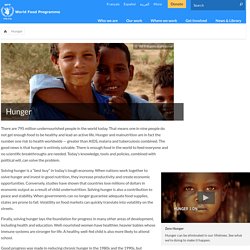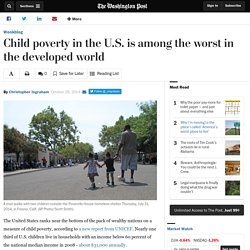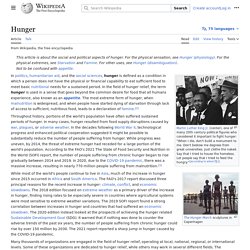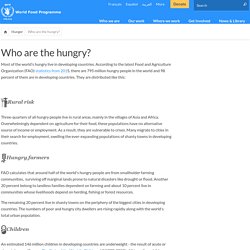

alexis l johnson
Hunger. There are 795 million undernourished people in the world today.

That means one in nine people do not get enough food to be healthy and lead an active life. Hunger and malnutrition are in fact the number one risk to health worldwide — greater than AIDS, malaria and tuberculosis combined. The good news is that hunger is entirely solvable. There is enough food in the world to feed everyone and no scientific breakthroughs are needed. Sites to look at. Child poverty in the U.S. is among the worst in the developed world. A man walks with two children outside the Poverello House homeless shelter Thursday, July 31, 2014, in Fresno, Calif.

(AP Photo/Scott Smith) The United States ranks near the bottom of the pack of wealthy nations on a measure of child poverty, according to a new report from UNICEF. Nearly one third of U.S. children live in households with an income below 60 percent of the national median income in 2008 - about $31,000 annually. In the richest nation in the world, one in three kids live in poverty. Let that sink in. The UNICEF report pegs the poverty definition to the 2008 median to account for the decline in income since then - incomes fell after the great recession, so measuring this way is an attempt to assess current poverty relative to how things stood before the downturn.
With 32.2 percent of children living below this line, the U.S. ranks 36th out of the 41 wealthy countries included in the UNICEF report. Map: Childhood poverty rates, by state. America's largest organization for youth volunteering opportunities, with 4 million members. Poor Children Are Twice As Likely To Die Before 5th Birthday Than Rich: UN. Freedom from Hunger. World Hunger Facts: Causes, Effects and Solutions This year, nearly 9 million children younger than five years old will die needlessly, more than half from hunger-related causes.1Few of these deaths are related to outright starvation, but rather to common illnesses (such as diarrhea, malaria and measles) that move in on vulnerable children whose bodies have been weakened by hunger.2Freedom from Hunger concentrates its services in the world's poorest nations, where an overwhelming 32% are moderately to severely stunted—seriously below normal height for one's age.2In the developing world, more than 1.4 billion people currently live below the international poverty line, earning less than $1.25 per day.3Among this group of poor people, many have problems obtaining adequate, nutritious food for themselves and their families.

World Hunger and Poverty. Author and Page information by Anup ShahThis Page Last Updated Sunday, August 22, 2010 We often hear about people’s desire to solve world hunger, or to be able to feed the world and help alleviate the suffering associated with it.

However, meaningful long-term alleviation to hunger is rooted in the alleviation of poverty, as poverty leads to hunger. World hunger is a terrible symptom of world poverty. If efforts are only directed at providing food, or improving food production or distribution, then the structural root causes that create hunger, poverty and dependency would still remain. 4 articles on “World Hunger and Poverty” and 3 related issues: United Nations World Food Programme - Fighting Hunger Worldwide.
Hunger. The FAO's food price index reflects changes in the average international price of food.

The sharp rise in 2007/08 caused a global food crisis, with food riots in dozens of countries, and pushed well over a hundred million into extreme hunger. The sharp rise in 2010/11 contributed to the Arab Spring. World cereal production per capita shows a steady increase. With a kilogram per capita per day, there would be enough for everybody, if it were not for prices being too high or incomes too low for some.
In politics, humanitarian aid, and social science, hunger is a condition in which a person, for a sustained period, is unable to eat sufficient food to meet basic nutritional needs. Throughout history, portions of the world's population have often experienced sustained periods of hunger. Until 2006, the average international price of food had been largely stable for several decades. As a physical condition[edit] Who are the hungry? Most of the world’s hungry live in developing countries.

According to the latest Food and Agriculture Organization (FAO) statistics from 2015, there are 795 million hungry people in the world and 98 percent of them are in developing countries. They are distributed like this: Rural risk Three-quarters of all hungry people live in rural areas, mainly in the villages of Asia and Africa. Overwhelmingly dependent on agriculture for their food, these populations have no alternative source of income or employment. Hungry farmers FAO calculates that around half of the world's hungry people are from smallholder farming communities, surviving off marginal lands prone to natural disasters like drought or flood.
World Hunger @ The Hunger Site. For most of us, hunger is short-term problem with a simple and foreseeable solution: easy access to a wide array of food and nutrition choices.

But for one-eighth of all of the people in the world, hunger is a daily, inescapable reality. The Food and Agriculture Organization (FAO) reports that 868 million people across the world are suffering from chronic hunger, emphasizing that although it has declined for the first time in fifteen years, that number remains "unacceptably high.
" FAO Director-General Jaques Diouf states: "The silent hunger crisis affecting humanity poses a serious risk for world peace and security. We urgently need to forge a broad consensus on the total and rapid eradication of hunger in the world and to take the necessary actions. "